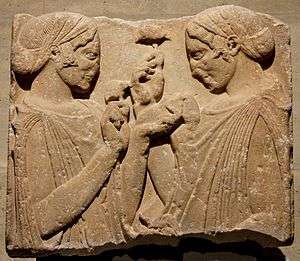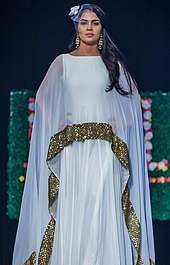Peplos
A peplos (Greek: ὁ πέπλος) is a body-length garment established as typical attire for women in ancient Greece by 500 BC (the Classical period). It was a long, tubular cloth with the top edge folded down about halfway, so that what was the top of the tube was now draped below the waist, and the bottom of the tube was at the ankle. The garment was then gathered about the waist and the folded top edge pinned over the shoulders. The folded-down top of the tube provided the appearance of a second piece of clothing. (The Caryatid statues show a typical drapery.)[1]

The peplos was draped and open on one side of the body, like the Doric chiton. It should not be confused with the Ionic chiton, which was a piece of fabric folded over and sewn together along the longer side to form a tube. The Classical garment is represented in Greek vase painting from the 5th century BC and in the metopes of temples in Doric order.
Spartan women continued to wear the peplos much later in history than other Greek cultures. It was also shorter and with slits on the side causing other Greeks to call them phainomērídes (φαινομηρίδες) the "thigh-showers".
Rituals
On the last day of the month Pyanepsion, the priestess of Athena Polias and the Arrephoroi, a group of girls chosen to help in the making of the sacred peplos, set up the loom on which the enormous peplos was to be woven by the Ergastinai, another group of girls chosen to spend about nine months making the sacred peplos. They had to weave a theme of Athena's defeat of Enkelados and the Olympian's defeat of the Giants. The peplos of the statue was changed each year during the Plynteria.
The peplos played a role in the Athenian festival of the Great Panathenaea. Nine months before the festival, at the arts and crafts festival titled Chalkeia, a special peplos would begin to be woven by young women. This peplos was placed on the statue of Athena during the festival procession. The peplos had myths and stories woven into its material and usually consisted of purple and saffron yellow cloth.
In modern fashion

The peplum dress has been revived several times in the modern era due to longstanding admiration for Greek culture. Regency era women wore translucent shift dresses in keeping with the neoclassical architecture and interior design which favoured white marble and pale pastel colors. From the 1950s until the 1970s, classical inspired dresses became part of mainstream British and American fashion due to the emerging popularity of Italian peplum films and package holidays to the Mediterranean. These were revived again during the 1990s and 2010s due to nostalgia for the disco era and Old Hollywood glamour.
References
- Ancient Greek Dress Heilbrunn Timeline of Art History, Metropolitan Museum of Art, 2000-2013. Retrieved 7 October 2013.



